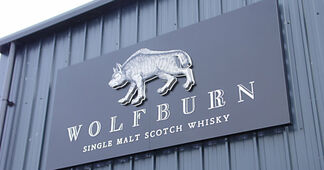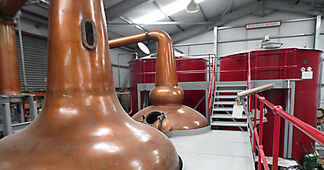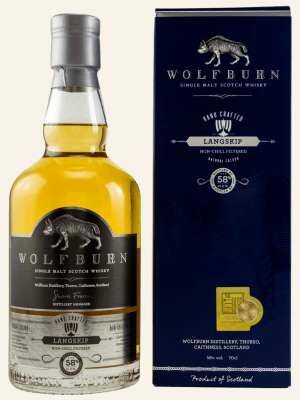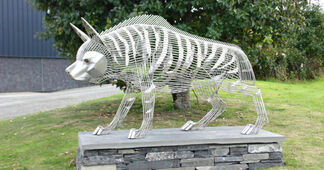
Wolfburn Distillery
The Wolf of the North
Thurso & Wolfburn Distillery
Wolfburn Distillery sits just outside the town of Thurso and is the most northern distillery on mainland Scotland. Thurso itself is the most northerly town on the British mainland. Records date back to Viking times, when it was under Norse Orcadian rule and a major gateway to Scandinavia and the Northern Isles. The area is fringed to the north and east by dramatic coastal scenery and is home to internationally important colonies of sea birds.
Thurso Bay and the distillery overlook the turbulent waters of the Pentland Firth towards the imposing cliffs of the Orcadian Island of Hoy – on a clear day the Old Man of Hoy can be seen in the far distance. The Thurso area was inhabited long before the Vikings arrived to give it its name.
The Flow Country covers much of Caithness and has done so since the end of the last ice age. It is an ancient and almost unique environment, the largest expanse of blanket peat bog in Europe, perhaps the entire world. It is up for nomination to be a World Heritage site. And is a perfect place for a distillery!
Wolfburn has four core-range whiskies, all of which retail for under 50€ per bottle which to me is a real bargain!
The Early Wolfburn Distillery
Wolfburn Distillery was founded just to the west of the town of Thurso, Caithness, in 1821 by William Smith. The distillery was of considerable size for its day and ran as a successful commercial enterprise for several decades, being handed down through several generations of the Smith family. It is thought to have ceased production during the 1850s, although the exact date is a matter of debate. The reasons for its demise are unclear - very little remains of the original distillery and there are no known photographs. However, records of its annual production volumes of whisky can be found in tax returns, which show it producing 28,056 “Total Gallons of Proof Spirit” during 1826 (roughly 125,000 litres) – making it the biggest distillery in Caithness at the time.
In 1872 the first Ordnance Survey map of the region was published and this showed the distillery to be in ruin, yet in 1877 when the next edition of the map was released the words ‘in ruins’ had been removed. It may be that the distillery worked intermittently towards the end of its past life.

The Re-Birth of Wolfburn
The opening of 21st century Wolfburn was more of an exercise in archaeology than a process of bringing a disused plant back to life. In May 2011 one of the team went to locate the site of the old Wolfburn distillery in Thurso, Caithness. After 150 years of neglect they found a barely discernible pile of stones, but the cold crystal clear waters of the Wolf Burn were still flowing just as they always had. The dream was there. Land was purchased in May 2012, just 350 meters from the original site. The first ground was broken a few months later in early August and by the end of September the structures of the new buildings were beginning to take shape.By November, hand beaten stills from Speyside were transported to the far northern extremes of the Highlands and the teams worked throughout the Winter darkness and cold until eventually the Wolfburn Distillery was proudly commissioned in the New Year, and on the 25th January 2013 (Burns Night) new spirit started to flow.
In February 2016 the new Wolfburn Distillery commenced bottling operations, in a purpose-built on-site bottling facility. The inaugural whisky was launched globally in March 2016 and has gone on to win several gold medal awards in international competitions.
The reinvented Wolfburn site consists of four buildings: the distillery itself and three warehouses for the laying down of casks.

The New Distillery and Its Whisky
The new distillery is not as enchanting and attractive as Edradour or Lindores Abbey that I wrote about recently. But it is functional – almost industrial – and modern. Here is a link to a video tour of Wolfburn Distillery here.
At Wolfburn they allow a very long fermentation, averaging around 75 hours. That’s 50% longer than industry standard and arguably very inefficient, as the sugar has all turned to alcohol by around 50 hours. But it brings out some wonderful sweet, floral flavours, which carry right through distillation and maturation.
Wolfburn has four core-range whiskies, all of which retail for under 50€ per bottle which to me is a real bargain!
Northland
Matured in American oak quarter casks.
Aurora
A sherried whisky made from spirit laid down in American oak and Spanish Oloroso sherry casks.
Morven
A delicate touch of peat - matured in ex-bourbon barrels and quarter casks.
Langskip
Matured in first fill ex bourbon casks and bottled at 58%.

All of the whiskies to date are No Age Statement (NAS) which is a distillery philosophy that I believe will change as the whiskies reach 10+ years of age. Wolfburn have also released some special bottlings which are individual and usually named with a number. Watch out for these. There are some gems.
The Logo
The Wolfburn logo was designed in 2011 and is taken from a drawing by Conrad Gessner, the 16th Century linguist and zoologist, and appears in his work The History of Four-footed Beasts and Serpents. In Gessner’s day the wolf was a common sight in the far north of Scotland and on the coast it was said to have a supernatural relative: the sea-wolf.
The sea-wolf is also said to bring good luck to all those fortunate enough to see it. It's a long way up North, but I recommend the trip.
